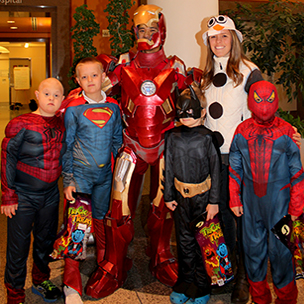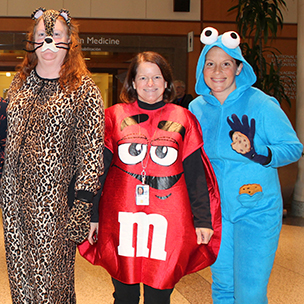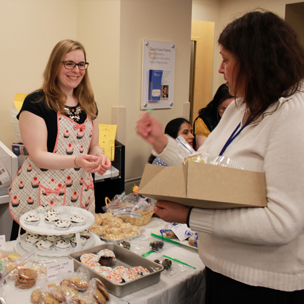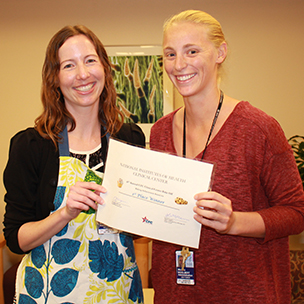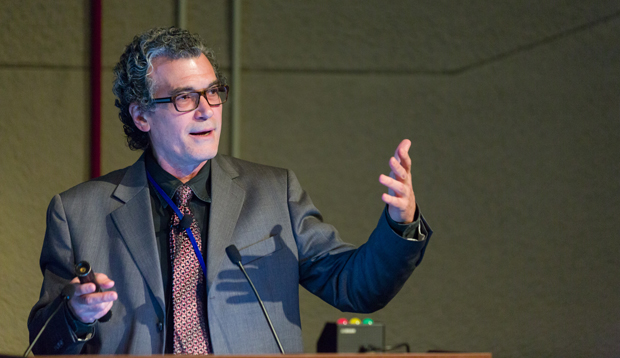

November 2015
IN THIS ISSUE:
![]()
- New phone helps patients arriving by Metro access campus after hours
- Native American scholars bring research to tribal communities
- Clever costumes and trick-or-treating bring Halloween to patients in the Clinical Center
- University of Wisconsin doctor presents on better ways to diagnose cardiovascular disorders during Doppman Memorial Lecture
- Dr. Carlos Zarate presents on relief from depression, suicidal ideation
- Fifth Floor art exhibit, "Lunch Bags from my Heart," showcases a former NIH staff member's creative and 'healthy distraction'
- Sweets and other treats sold for CFC charity
- Director of NIMHD addresses tobacco use among minorities
- Physical therapy fitness walks draws attention to Physical Therapy month, need for improving motion in people's lives
- NIH Leave Bank opens enrollment for staff
- This Thanksgiving, celebrate Family Health History Day
- Experts convene at NIH to share research on diagnosis, treatment of pancreatic cancer
- Clinical trials at NIH Clinical Center in need of participants
- Upcoming Events
Print this Issue ![]() (575 KB)
(575 KB)
ABOUT CC NEWS:
![]()
Published monthly by the Office of Communications and Media Relations. News, article ideas, calendar events, letters, and photographs are welcome. Submissions may be edited.
Clinical Center News
National Institutes of Health
Building 10, 10 Center Drive
Room 6-2551,
Bethesda, MD 20892-1504
Tel: 301-594-5789
Fax: 301-402-0244
Molly.hooven@nih.gov
2015 ISSUES:
![]()
QUICK LINKS:
![]()
New phone helps patients arriving by Metro access campus after hours
 |
The use of a solar-powered device to run the phone eliminated the need for disruptive and costly construction. |
The NIH recently installed a new solar-powered patient assistance phone at the Gateway Visitor Center campus entrance. The phone, similar to what's on college campuses or in large parking garages, helps patients arriving by foot from Metro find the appropriate entrance and route to the Clinical Center after hours and on weekends.
When a patient uses the phone, the patient is connected with the NIH Emergency Communications Center. The center confirms the patient's status with admissions and then directs the patient to proceed to the South Drive Vehicle Entrance. Once a patient gets to this entrance, a security officer will screen and badge the patient and arrange for transport into campus to the Clinical Center.
The installation of the phone is just one of many additions NIH has made to ease the patient experience getting onto campus. The Clinical Center, in partnership with NIH Office of Research Services, has also changed the signage on the visitor entrance of the Gateway Visitor Center, including the addition of a campus map to allow patients and visitors to better navigate to their destinations.
Native American scholars bring research to tribal communities
 |
To celebrate Native American Heritage Month, the Native American Scholars at the NIH gathered for a lunch titled "Growing Native Leaders: Enhancing Seven Generations" in Building 35 Nov 6. The lunch highlighted the rich history and culture of the tribal nations of North America and also the contributions, achievements, and sacrifices Native people have made throughout history. The menu included traditional tribal foods. Above, Native American Scholars Dr. Naomi Lee, Danielle Locust, Ryan Toledo, Geanna Capitan, Loretta Grey Cloud, and Dr. Teresa Brockie gather at the lunch. |
While Native American Heritage Month is celebrated in November, five NIH scholars dedicate their careers all year long to improving the health and wellbeing of Native Americans across the country. Dr. Teresa Brockie, one such scholar who works in the Clinical Center, is a post-doctoral fellow and research nurse specialist in the Nursing Department. She works with tribal nations in community-based participatory research to conduct health-related protocols.
Brockie, who is a member of the White Clay Nation, is currently working with the Assiniboine and Sioux tribes. With continual tribal engagement and communication, she is able to support research conducted on-site. Brockie has completed a study with tribal nation partners about suicide, and she hopes to conduct a study dealing with trauma-focused cognitive behavioral therapy in the new year. In a recent presentation about the suicide study for the American Public Health Association, members of Brockie's team provided the following reflections from the field:
"The benefits of involving the community were especially apparent during data collection; it was as if the research became theirs."
"Our team responded to participants in ways that were supportive and encouraging. We each had important roles. Having members of the community attending to relationships builds everyone's strength and capacity to heal."
"Many shared stories and had good comments about the study; they were so happy to be able to participate in research on a subject that has negatively impacted the community—this was an opportunity they never had before."
On Nov. 6, Brockie and other NIH employees celebrated Native American history and culture by honoring the mentors and supporters of the scholar program with a traditional food luncheon.
Clever costumes and trick-or-treating bring Halloween to patients in the Clinical Center
Pediatric patients, their families and staff from the NIH Clinical Center and The Children's Inn at NIH dressed up for Halloween and trick-or-treated in the Clinical Center Oct. 30. Left photo, Kevin Isgrig (Iron Man) from the National Institute on Deafness and Communication Disorders and Cristen Cravath (Olaf), from The Children's Inn at NIH, join a few superhero patients. Right photo, Karen Perkins, Kristin Johnsen and Laura Herbert join the festivities, which were organized by the Recreation Therapy Section of the Clinical Center Rehabilitation Medicine Department. |
University of Wisconsin doctor presents on better ways to diagnose cardiovascular disorders during Doppman Memorial Lecture
 |
Dr. Thomas Grist, keynote speaker at the Doppman Memorial Lecture, receives a certificate of appreciation from Dr. David Bluemke (left), director of the Clinical Center Radiology and Imaging Sciences department and Dr. John I. Gallin (right), director of the Clinical Center. |
Experts across the country use cardiac magnetic resonance imaging (MRI) to take both still and moving pictures of a beating heart. The tool allows them to look at the heart's structure and function to assess potential treatment. Dr. Thomas Grist, the keynote speaker of this year's John Doppman Memorial Lecture for Imaging Sciences, discussed this advanced tool and "New Developments in Cardiovascular MRI: From Form to Function."
As the chair of the department of radiology at the University of Wisconsin School of Medicine and Public Health Grist focuses on advancing MRI and imaging therapy.
The Oct. 21 lecture marked the 15th anniversary of the series honoring Dr. John Doppman who was a diagnostic and interventional radiologist at the Clinical Center for 36 years. Doppman served as chair of the diagnostic radiology department for 28 of those years. During his tenure, the department was one of the first to have both computed tomography (CT) and MRI scanners.
During the lecture, Grist provided background on the development of qualitative and quantitative 4D Flow MRI and its applications for diagnosing and guiding the treatment of cardiovascular disorders. This type of MRI helps experts measure bloodflow patterns in 3D images and allows them to better diagnose and create better therapeutic management techniques for cardiovascular diseases.
This type of new research and development in technology has reduced the time needed to capture and analyze the data, making these techniques more feasible for clinical use.
Looking forward, "we need better tools for processing and analyzing these data," said Grist. "I think those tools will come. We have gone from initially taking a few days to process these images, and now we are down to actually processing the images and rendering reports within a few hours, and that's a pretty dramatic revelation that it requires this team approach between radiology, medical physics and visualization labs."
Dr. Carlos Zarate presents on relief from depression, suicidal ideation
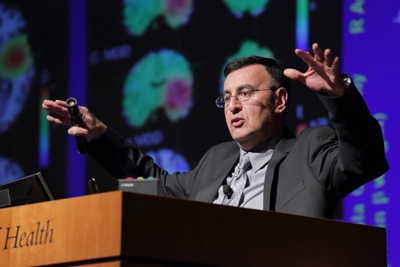 |
Dr. Carlos Zarate spoke about the current concept of depression, diagnosis, morbidity and mortality during the Oct. 28 lecture in Masur Auditorium. Later, Dr. John I. Gallin, director of the Clinical Center, presented Zarate with a plaque in honor of his outstanding scientific accomplishments and leadership. |
On Oct. 28, Dr. Carlos Zarate presented a lecture as part of the annual Astute Clinician Lecture series held at the Clinical Center. The lecture was titled Relief from Severe Depression and Suicidal Ideation Within Hours: from Synapses to Symptoms. Since 1998, scientists, such as Zarate, have had the honor of speaking at the lecture series because they have observed an unusual clinical occurrence, and by investigating it, have opened an important new avenue of research.
Zarates, a senior investigator in the National Institute of Mental Health (NIMH), spoke about new treatments that expedite the time it takes to address severe depression and suicidal ideations shortening the duration from 8-10 weeks to 8-10 hours.
During his presentation, Zarate pulled up a case vignette that described a patient with 35-year history of severe, refractory major depression and co-morbid social phobia and past posttraumatic stress disorder and alcohol dependence. He had a suicide attempt and was admitted to NIMH. Reading off the PowerPoint slide, Zarate said "The patient had a ketamine infusion and found within a few hours his depression and suicidal thinking was gone. He continued well until 20 days after a single infusion of ketamine."
The lecture, which is a part of the NIH Director's Wednesday Afternoon Lecture Series, was established 17 years ago through a gift from Dr. Robert W. Miller and his wife Haruko. Miller was a scientist emeritus at the National Cancer Institute (NCI) whose work led to a new understanding of cancer genetics. His wife was a research chemistry technician at NCI for most of her 27 years at NIH.
Fifth Floor art exhibit, "Lunch Bags from my Heart," showcases a former NIH staff member's creative and 'healthy distraction'
 |
More than 12 lunch bags fill the art cases on the 5th floor with Judy Weisbergs's lunchtime creations for her husband, a former employee in the Clinical Center. |
Dating as far back as the 1980s, Judy Weisberg packed lunch for her husband Bob to bring to work here at the Clinical Center. He served as the head of microbial genetics within the National Institute of Child Health and Development Program in Genomics of Development. Like many others, he, too, enjoyed those peak hours of the day when we get to refuel our minds and hearts with tastes and satisfaction of home-cooked food. However, what was special about Bob's lunch was not only the meals, but the paper bags each was packed in.
Decorated by Judy, the brown bags were enlivened with assorted stickers, news clippings and photos arranged in a way to bring fun and to serve as a "healthy distraction" for Bob and fellow staff members. Whether reflecting a trip they had taken as a couple over their 50+ years of marriage, poking fun at national topics or representing a holiday theme, each served as a conversation starter and a brief diversion from the 'call of science.'
In memory of Bob, who passed away in 2011 and of all of the years of dedication he gave to NIH, an art exhibit has been created by Judy to showcase a sample of some of these lunch bags. The exhibit demonstrates creativity and thoughtfulness.
"The audience may be different; but if those selected bags can bring smiles or fun and distraction into the days of any patients, caregivers or employees, then I'd say the exhibit is doing its job," Judy said.
The bags offer a glimpse into the personal life of not only a dedicated researcher but also a dedicated wife who supported him throughout the years. "If viewers can 'connect' in some way with what's being presented, my fondest hope would be realized," Judy said. The exhibit will be on display through December and is located on the 5th floor of the Clinical Center in front of the Medical Surgical Telemetry Inpatient Unit (5SE). The lunch bags and the rest of the collection have also been converted into a memoir: www.tinyurl.com/judybag [disclaimer].
Sweets and other treats sold for CFC charity
On Oct. 27, participants in the 2015 Annual Clinical Center Combined Federal Campaign (CFC) Bake Off raised around $2,200 for charity. Employees and CFC keyworkers, lined the hallways near the 2nd floor cafeteria with tables overflowing with delicious treats. Keyworker Rachel Wolf, seen above, made gluten free and kosher baked goods for the event. More than 20 departments, units and other areas within the Clinical Center participated. In the right photo, Rachael Schacherer (left) presented Michele Woolbert (right) from the Office of Administrative Management the 1st place prize in the Bake Off competition. |
Director of NIMHD addresses tobacco use among minorities
In recognition of National Hispanic Heritage Month, Dr. Eliseo J. Pérez-Stable, the new director of the National Institute on Minority Health and Health Disparities, presented a lecture on Tobacco Use Behavior and Health Consequences among U.S. Racial/Ethnic Minorities. During the Oct. 13 presentation, Pérez- Stable discussed smoking prevalence rates by race/ ethnicity, light and non-daily smoking, the health effects of second-hand smoke, cessation patterns and interventions and biological factors in smoking behavior. |
Physical therapy fitness walks draws attention to Physical Therapy month, need for improving motion in people's lives
The Physical Therapists of the Clinical Center celebrated National Physical Therapy Month in October. Staff hosted two events: information booths outside the B1 and 2nd floor cafeterias and a Physical Therapy Month fitness walk within the NIH Bethesda campus. National Physical Therapy Month recognizes how physical therapists and physical therapist assistants help transform society by restoring and improving motion in people's lives.
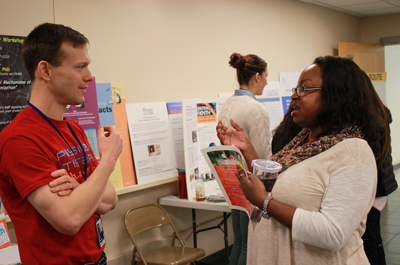 |
Paul Stout (left) answers questions from Angela Combs at the physical therapy month information booth outside of the Clinical Center's 2nd floor cafeteria. |
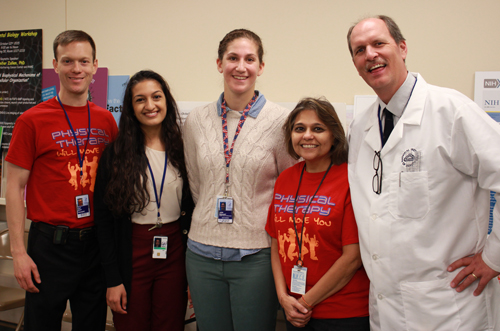 |
From left to right, physical therapist Paul Stout, NIH Intramural Research Program Postdoctoral Research Training Awardees Ruhi Vasavada and Julie Rekant and physical therapists Minal Jain and Joe Shrader staff the information booth outside of the Clinical Center's 2nd floor cafeteria. |
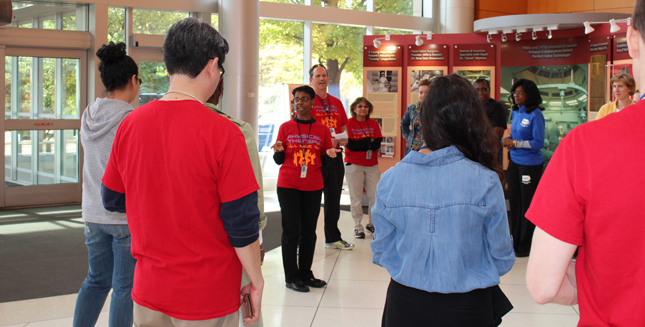 |
Capt. Michaele Smith, chief of the Clinical Center's physical therapy section, addresses staff gathered for the Physical Therapy Month fitness walk. |
NIH Leave Bank opens enrollment for staff
The NIH Leave Bank has open enrollment for NIH employees until Dec. 14. The program provides leave to employees who are experiencing a serious medical condition, or who have a family member experiencing such a condition.
Employees become members in the Leave Bank by donating one pay period's worth of annual leave accrual (so four, six or eight hours of annual leave depending on length of service). Individuals with insufficient leave to make a contribution can be given a waiver. Once they are members, employees are eligible to receive up to 480 hours of donated leave for a personal medical issue, and up to 240 hours of donated leave for a family medical emergency, for a potential total of 720 hours per leave year.
This program is particularly helpful for new employees who face an unexpected medical emergency and who most likely do not have enough hours to cover their expected absence from work. Of course, it can also be useful for longer-term employees whose leave balances might not be sufficient to deal with a crisis. The Leave Bank can be used in conjunction with the Voluntary Leave Transfer Program, so employees facing an extended period of absence can avail themselves of both programs.
Typically, a newly-hired employee has 60 days from starting to request membership in the Leave Bank. Existing employees can elect to join the Leave Bank during Open Enrollment. Current members will be automatically renewed unless they choose to opt-out during this time. All those joining during this open enrollment period will be eligible to receive hours starting Jan. 10, 2016.
For more details visit: https://hr.od.nih.gov/benefits/leave/vlbp/default.htm or email maurercs@cc.nih.gov.
This Thanksgiving, celebrate Family Health History DayThis Thanksgiving, cook up your unique recipe for wellness and disease prevention and create a family health portrait using the Family Health History tool created by the U.S. Surgeon General with help from the National Human Genome Research Institute, part of the National Institutes of Health. |
Experts convene at NIH to share research on diagnosis, treatment of pancreatic cancer
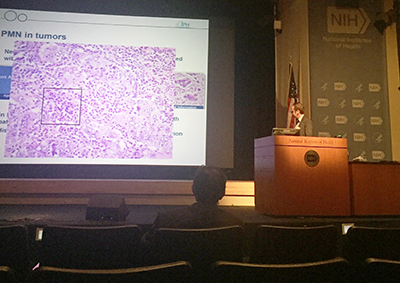 |
Dr. Matthias Gaida, from Institute of Pathology, University of Heidelberg, Germany presents at the 3rd Pancreatic Cancer Symposium, "Current Advances and Future Challenges in Research and Treatment" Sept. 28-29, 2015. |
In late September, pancreatic cancer experts from across the country and Europe met in the Clinical Center for the National Cancer Institute's (NCI) 3rd Pancreatic Cancer Symposium. Organized by the NCI Pancreatic Cancer Interest Group, this year's symposium, "Current Advances and Future Challenges in Research and Treatment," focused on recent advances in understanding the development, progression, early detection and treatment of pancreatic cancer.
Dr. Perwez Hussain, chair of the NCI Pancreatic Cancer Interest Group and head of the Pancreatic Cancer Unit in the NCI Laboratory of Human Carcinogenesis, shared that the symposium has opened several doors for research collaborations between NIH and outside leading experts.
"The major highlight of this symposium is bringing clinicians and translational researchers on the same stage to ask each other questions eye-to-eye. If you really want to improve outcomes for patients, these discussions are critical," said Hussain.
A few of those questions led to robust discussions among panelists and audience members. For example, participants shared perspectives on how to manage pre-cancerous cysts in the pancreas and how close we are to clinically validating markers that will tell doctors which cysts will develop into cancerous tumors. The symposium keynote speaker, Dr. Christine Iacobuzio-Donahue, from the Memorial Sloan Kettering Cancer Center in New York, shared her work on differences within individual tumors and how a comprehensive understanding of this heterogeneity may help identify more therapeutic opportunities for patients with pancreatic cancer. Other presentations focused on improving screening for known familial traits associated with pancreatic cancer and identifying individuals with precursor lesions known to cause pancreatic cancer; targeting of inflammatory mediators and metabolic pathways; and improving research in immunotherapy to get better outcomes in clinical trials.
The NCI Pancreatic Cancer Interest Group consists of NCI researchers who meet twice a month to exchange ideas and share ongoing studies to foster collaboration in pancreatic cancer research across NIH. View pancreatic cancer trials. Read NCI's Cancer Currents blog.
Clinical trials at NIH Clinical Center in need of participants
National Institute of Nursing Research (NINR) seeks people who completed radiation therapy for cancer to participate in a study. Some people have persistent clinically significant fatigue after receiving radiation therapy. Researchers want to test if the medication, ketamine, can reduce this fatigue. Study procedures take place at the NIH Clinical Center. Study-related tests and medication are provided at no cost. Travel costs will be reimbursed in accordance with NIH guidelines. Study# 15-NR-0037.
A research team with National Cancer Institute (NCI) is testing if the medication, anakinra, is an effective therapy to treat adults with pustular skin diseases. If you have an inflammatory pustular skin condition, you may be interested in participating. Study# 13-C-0071.
An NIH research study is enrolling healthy persons ages 18 to 65 who are free of psychiatric disorders and certain medical conditions. Researchers will evaluate the effects of the experimental medication ketamine on brain receptors in healthy and depressed adults. Research includes 1 to 6 weeks of outpatient procedures: a screening visit, computer tasks, rating scales, neuropsychological testing, two intravenous infusions, a blood draw, brain scans (MEG & fMRI); and may include optional 2-4 overnight stays for a sleep study. The study is conducted at the NIH Clinical Center in Bethesda, MD. There is no cost to participate and compensation is provided. To find out if you qualify, email moodresearch@mail.nih.gov or call 1-877-MIND-NIH, (1-877-646-3644). Study# 04-M-0222.
For more information on the studies above or others available, call the NIH Office of Patient Recruitment 1-866-444-2214, (TTY 1-866- 411-1010) or visit www.clinicaltrials.gov.
Upcoming Events
Most lectures will be streamed live and archived
Clinical Center Family Caregiver Day Fair and Expo
Nov. 17, 2015, 11:00 a.m. – 2:00 p.m.
7th floor, Clinical Research Center
NIH and outside exhibitor resources will be available for family caregivers. No registration required.
Clinical Center Grand Rounds Lecture
Clinicopathologic Grand Rounds: Clinical Cases from the NIH Clinical Center
Chronic Graft-Versus-Host Disease: A Team Approach
Nov. 18, 2015, Noon – 1:00 p.m.
Lipsett Amphitheater
Presented by Steven Z. Pavletic, MD, NCI, Edward Cowen, MD, NCI and Fran Hakim, PhD, NCI.
12th Annual Gingerbread House Decorating Contest
Dec. 7, 2015 – Jan. 4, 2016
Atrium
Vote for your favorite decorated house in the Clinical Center's north atrium or on Facebook and get into the holiday spirit. Contact Ann Marie Matlock for more information: amatlock@cc.nih.gov.
NIH Director's Wednesday Afternoon Lecture Series
G. Burroughs Mider Lecture: Imaging Immunity
Dec. 9, 2015, 3:00 p.m. – 4:00 p.m.
Masur Auditorium
Presented by Ronald N. Germain, MD, NIAID.
NIH Clinical Center Director's Annual Address and Awards Ceremony
Dec.18, 2015, 1:00 p.m. – 3:00 p.m.
Masur Auditorium
The event will honor Clinical Center employees and their exemplary contribution to NIH.
NOTE: PDF documents require the free Adobe Reader.
 The information on this page is archived and provided for reference purposes only.
The information on this page is archived and provided for reference purposes only.